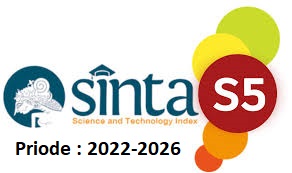Analisis Algoritma C4.5 untuk Prediksi Minat Baca
DOI:
https://doi.org/10.36085/jtis.v8i1.8834Keywords:
Decision tree C4.5, Minat baca, Machine learning, Supervised LearningAbstract
Minat baca merupakan indikator penting dari tingkat literasi dan berkorelasi langsung dengan kemampuan berpikir analitis dan kualitas pendidikan secara keseluruhan. Prediksi minat baca dapat diselesaikan dengan pendekatan machine leraning menggunakan algoritma C4.5 yang handal dalam mengolah data. Berdasarkan hasil analisis yang telah dilakukan, diperoleh pohon keputusan C4.5 untuk prediksi minat baca, di mana variabel lingkungan membaca tidak mempengaruhi prediksi minat baca, sedangkan variabel umur yang paling berpengaruh terhadap prediksi minat baca. Sedangkan hasil evaluasi model menggunakan confusion matrix menghasilkan akurasi sebesar 71.14%, dimana menurut tafsiran guilford empirical rules akurasi tersebut termasuk tinggi/handal. Hasil interval kepercayaan didapatkan batas atas = 0.743437, dan batas bawah = 0.6771. Dengan demikian diperoleh model C4.5 untuk prediksi minat baca yang akurasinya tinggi/handal.
References
P. N. RI, “Statistik Perpustakaan dan Minat Baca Masyarakat,” 2023. https://perpusnas.go.id/
U. I. for Statistics, “Literacy rates and UIS literacy survey,” 2022. https://uis.unesco.org/en/literacy-rates
A. Habók, A. Magyar, M. B. Németh, dan B. Csapó, “Motivation and self-related beliefs as predictors of academic achievement in reading and mathematics: Structural equation models of longitudinal data,” Int. J. Educ. Res., vol. 103, hal. 101634, 2020, doi: 10.1016/j.ijer.2020.101634.
A. A. Nguyen, T. T. M., & Putra, “Comparative analysis of reading habits in ASEAN countries: Implications for educational policy,” Asian Educ. Dev. Stud., vol. 9, no. 3, hal. 321–335, 2020, doi: https://doi.org/10.1108/AEDS-03-2019-0056.
R. S. Wahono, “Literature Review: Pengantar Dan Metode.” https://romisatriawahono.net/2016/05/07/literature-review-pengantar-dan-metode/
R. T. Huang, Z., & Rust, “Artificial intelligence in service,” J. Serv. Res., vol. 24, no. 2, hal. 155–176, 2021, doi: https://doi.org/10.1177/1094670520986712.
A. Tuan Hoang dkk., “A review on application of artificial neural network (ANN) for performance and emission characteristics of diesel engine fueled with biodiesel-based fuels,” Sustain. Energy Technol. Assessments, vol. 47, hal. 101416, Okt 2021, doi: 10.1016/j.seta.2021.101416.
D. Valero-Carreras, J. Alcaraz, dan M. Landete, “Comparing two SVM models through different metrics based on the confusion matrix,” Comput. Oper. Res., vol. 152, hal. 106131, Apr 2023, doi: 10.1016/j.cor.2022.106131.
W. C. Leong, A. Bahadori, J. Zhang, dan Z. Ahmad, “Prediction of water quality index (WQI) using support vector machine (SVM) and least square-support vector machine (LS-SVM),” Int. J. River Basin Manag., vol. 19, no. 2, hal. 149–156, Apr 2021, doi: 10.1080/15715124.2019.1628030.
R. K. Halder, M. N. Uddin, M. A. Uddin, S. Aryal, dan A. Khraisat, “Enhancing K-nearest neighbor algorithm: a comprehensive review and performance analysis of modifications,” J. Big Data, vol. 11, no. 1, hal. 113, Agu 2024, doi: 10.1186/s40537-024-00973-y.
A. Laios, A. Gryparis, D. DeJong, R. Hutson, G. Theophilou, dan C. Leach, “Predicting complete cytoreduction for advanced ovarian cancer patients using nearest-neighbor models,” J. Ovarian Res., vol. 13, no. 1, hal. 117, Des 2020, doi: 10.1186/s13048-020-00700-0.
M. Yunus, M. K. Biddinika, dan A. Fadlil, “Classification of Stunting in Children Using the C4.5 Algorithm,” J. Online Inform., vol. 8, no. 1, hal. 99–106, Jun 2023, doi: 10.15575/join.v8i1.1062.
A. Kurani, P. Doshi, A. Vakharia, dan M. Shah, “A Comprehensive Comparative Study of Artificial Neural Network (ANN) and Support Vector Machines (SVM) on Stock Forecasting,” Ann. Data Sci., vol. 10, no. 1, hal. 183–208, Feb 2023, doi: 10.1007/s40745-021-00344-x.
S. Thudumu, P. Branch, J. Jin, dan J. Singh, “A comprehensive survey of anomaly detection techniques for high dimensional big data,” J. Big Data, vol. 7, no. 1, hal. 42, Des 2020, doi: 10.1186/s40537-020-00320-x.
J. He, C. Song, Q. Luo, L. Lan, C. Yang, dan W. Gui, “Noise-robust self-adaptive support vector machine for residual oxygen concentration measurement,” IEEE Trans. Instrum. Meas., hal. 1–1, 2020, doi: 10.1109/TIM.2020.2987049.
R. T. Wiyono dan N. D. W. Cahyani, “Performance Analysis of Decision Tree C4.5 as a Classification Technique to Conduct Network Forensics for Botnet Activities in Internet of Things,” in 2020 International Conference on Data Science and Its Applications (ICoDSA), IEEE, Agu 2020, hal. 1–5. doi: 10.1109/ICoDSA50139.2020.9212932.
A. A. Dehghani, N. Movahedi, K. Ghorbani, dan S. Eslamian, “Decision tree algorithms,” in Handbook of Hydroinformatics, Elsevier, 2023, hal. 171–187. doi: 10.1016/B978-0-12-821285-1.00004-X.
V.-H. Nhu, T. T. Bui, L. N. My, H. Vuong, dan H. N. Duc, “A new approach based on integration of random subspace and C4.5 decision tree learning method for spatial prediction of shallow landslides,” Vietnam J. Earth Sci., Feb 2022, doi: 10.15625/2615-9783/16929.
P. Chen, “The Application of an Improved C4.5 Decision Tree,” in 2021 7th Annual International Conference on Network and Information Systems for Computers (ICNISC), IEEE, Jul 2021, hal. 392–396. doi: 10.1109/ICNISC54316.2021.00078.
M. Ahmad, N. A. Al-Shayea, X.-W. Tang, A. Jamal, H. M. Al-Ahmadi, dan F. Ahmad, “Predicting the Pillar Stability of Underground Mines with Random Trees and C4.5 Decision Trees,” Appl. Sci., vol. 10, no. 18, hal. 6486, Sep 2020, doi: 10.3390/app10186486.










